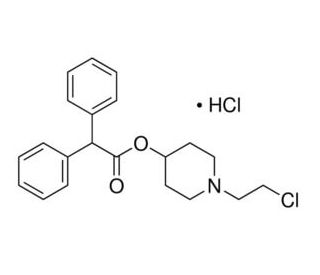

4-Diphenylacetoxy-N-(2-chloroethyl)piperidine hydrochloride (CAS 130817-71-9)
QUICK LINKS
4-Diphenylacetoxy-N-(2-chloroethyl)piperidine hydrochloride is a chemical compound that has garnered attention in various research applications due to its interaction with biological systems. In studies focusing on neurotransmission, this compound has been utilized to investigate the role of muscarinic receptors in the nervous system. It serves as a tool in understanding the mechanisms by which these receptors influence neurological pathways and functions. Additionally, the chemical′s structure allows researchers to explore binding affinity and selectivity towards different receptor subtypes within the muscarinic family. In biochemical assays, 4-Diphenylacetoxy-N-(2-chloroethyl)piperidine hydrochloride has been used to elucidate the signaling pathways that are modulated by receptor-ligand interactions, contributing to a broader understanding of cellular communication processes. The compound is also of interest in the study of enzyme-substrate relationships, particularly in scenarios where acetylcholine esterase activity is a focal point.
4-Diphenylacetoxy-N-(2-chloroethyl)piperidine hydrochloride (CAS 130817-71-9) References
- Muscarinic receptors mediate enhancement of spontaneous GABA release in the chick brain. | Guo, JZ. and Chiappinelli, VA. 2000. Neuroscience. 95: 273-82. PMID: 10619484
- M2-receptor subtype does not mediate muscarine-induced increases in [Ca(2+)](i) in nociceptive neurons of rat dorsal root ganglia. | Haberberger, R., et al. 2000. J Neurophysiol. 84: 1934-41. PMID: 11024086
- Neural pathways regulating Brunner's gland secretion in guinea pig duodenum in vitro. | Moore, BA., et al. 2000. Am J Physiol Gastrointest Liver Physiol. 279: G910-7. PMID: 11052987
- Distinct muscarinic receptors enhance spontaneous GABA release and inhibit electrically evoked GABAergic synaptic transmission in the chick lateral spiriform nucleus. | Guo, J. and Chiappinelli, VA. 2001. Neuroscience. 104: 1057-66. PMID: 11457590
- Activation of mitogen-activated protein kinase by cholinergic agonists and EGF in human compared with rat cultured conjunctival goblet cells. | Horikawa, Y., et al. 2003. Invest Ophthalmol Vis Sci. 44: 2535-44. PMID: 12766054
- Muscarinic receptor subtypes in the human colon: lack of evidence for atypical subtypes. | Mansfield, KJ., et al. 2003. Eur J Pharmacol. 482: 101-9. PMID: 14660010
- Histamine innervation and activation of septohippocampal GABAergic neurones: involvement of local ACh release. | Xu, C., et al. 2004. J Physiol. 561: 657-70. PMID: 15486020
- Muscarinic regulation of neonatal rat bladder spontaneous contractions. | Ng, YK., et al. 2006. Am J Physiol Regul Integr Comp Physiol. 291: R1049-59. PMID: 16709645
- Anoctamins and gastrointestinal smooth muscle excitability. | Sanders, KM., et al. 2012. Exp Physiol. 97: 200-6. PMID: 22002868
- Selective inactivation of muscarinic receptor subtypes. | Eglen, RM., et al. 1994. Int J Biochem. 26: 1357-68. PMID: 7890115
- The effect of muscarinic receptor alkylation on endothelium-dependent vasodilation in SHR. | Hendriks, MG., et al. 1993. Blood Press. 2: 332-8. PMID: 8173704
- Neurohormonal modulation of rat enterochromaffin-like cell histamine secretion. | Sandor, A., et al. 1996. Gastroenterology. 110: 1084-92. PMID: 8612997
- Phenoxybenzamine and benextramine, but not 4-diphenylacetoxy-N-[2-chloroethyl] piperidine hydrochloride, display irreversible noncompetitive antagonism at G protein-coupled receptors. | Bodenstein, J., Venter, D. P., & Brink, C. B.). (2005. Journal of Pharmacology and Experimental Therapeutics,. 314(2):, 891-905.
Ordering Information
| Product Name | Catalog # | UNIT | Price | Qty | FAVORITES | |
4-Diphenylacetoxy-N-(2-chloroethyl)piperidine hydrochloride, 25 mg | sc-252148 | 25 mg | $250.00 | |||
4-Diphenylacetoxy-N-(2-chloroethyl)piperidine hydrochloride, 100 mg | sc-252148A | 100 mg | $850.00 |
